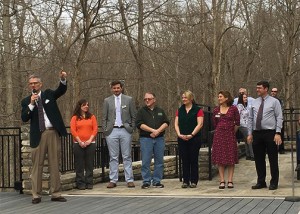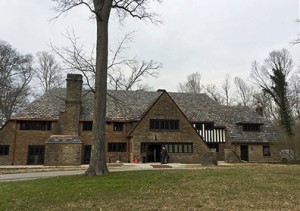
By Brett Milam
Editor
More than 100 people turned out for the grand opening of the Center for Conservation in Milford on March 25.

The Cincinnati Nature Center at 4949 Tealtown Road and specifically, Rowe Woods, was the site for a celebration 50 years in the making.
Started in 1967, the Cincinnati Nature Center is celebrating its 50th anniversary this year.
The start of that celebration is the restored and renovated Groesbeck Lodge in Rowe Woods, a nearly century-old home, according to Dr. Cory Christopher, the director of the center.
The house will be used for office space for the Department of Conservation’s staff and volunteers, and a research lab and opportunities for educational classes and public workshops.
Guests could tour the Center and see the research lab, which featured an exhibit on butterflies and the new offices.
Paul Haffner, who was named to board chair of the Center in August 2016, said it’s a beautiful building.
“We appreciate everyone’s support in helping us restore the Groesbeck home into a world-class facility that will serve as a real treasure for land conservation in our region,” he said. “To do anything on this scale, you have to have vision.”
Haffner said there’s “no better way” to kick off 50 years of the Cincinnati Nature Center than opening this center for conservation.
Bill Hopple, the executive director of the Cincinnati Nature Center, said the home was originally with the Girl Scout Council of Southwest Ohio in 1957, but it was then passed on to the Presbytery of Cincinnati two years later.
The Presbytery of Cincinnati held on to it for the next 40 years.
In 2004, that’s when Hopple got the phone call asking if the Nature Center would like to buy 235 acres.
“Well, we said we want the land, we’re not so interested in the building, but we really want the land,” he said.
But four years ago, Hopple said they felt the Groesbeck house was the “last piece of the puzzle” and it was time to do something with it in response to the growth of the nature center.
It’s about helping people learn to take care of their own land, which is the real use of this building, he said.
Christopher also spoke, referring to how humbling it was to see everyone come out for the opening.
“As I was standing there and listening to Bill, I thought of what my father said when I switched from pre-med to ecology, he said, ‘What are you going to do with ecology?’” Christopher said. And now that I look around, honestly, I’m thinking, ‘I can do anything with an ecology degree.’”
Christopher said his dream for the center is that it becomes a “hub of activity.”
“I don’t want to see it become quiet and dusty,” he said.
He added that it’s ultimately about trying to re-wild and re-green the region, conserving greenspace.
“Please look for shortly on the horizon a lot of public engagement with stewardship; how people can take care of their own yards,” Christopher said.

Editor’s Note: The original version of this article incorrectly said the guests were on hand to “party like it’s 1967.” That’s in reference to the Center’s Back to Nature event, not the opening of the Center for Conservation.
